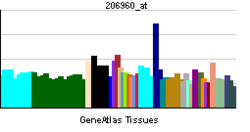- LPAR4
-
Lysophosphatidic acid receptor 4 Identifiers Symbols LPAR4; GPR23; LPA4; P2RY9; P2Y5-LIKE; P2Y9 External IDs OMIM: 300086 MGI: 1925384 HomoloGene: 3871 IUPHAR: GeneCards: LPAR4 Gene Gene Ontology Molecular function • receptor activity
• G-protein coupled receptor activity
• lipid binding
• purinergic nucleotide receptor activity, G-protein coupledCellular component • plasma membrane
• plasma membrane
• integral to plasma membraneBiological process • G-protein coupled receptor protein signaling pathway Sources: Amigo / QuickGO RNA expression pattern 
More reference expression data Orthologs Species Human Mouse Entrez 2846 78134 Ensembl ENSG00000147145 ENSMUSG00000049929 UniProt Q99677 Q80UD5 RefSeq (mRNA) NM_005296 NM_175271.4 RefSeq (protein) NP_005287 NP_780480.2 Location (UCSC) Chr X:
78 – 78.01 MbChr X:
104.12 – 104.13 MbPubMed search [1] [2] Lysophosphatidic acid receptor 4 also known as LPA4 is a protein that in humans is encoded by the LPAR4 gene.[1][2][3] LPA4 is a G protein-coupled receptor that binds the lipid signaling molecule lysophosphatidic acid (LPA).[4]
See also
References
- ^ "Entrez Gene: GPR23 G protein-coupled receptor 23". http://www.ncbi.nlm.nih.gov/sites/entrez?Db=gene&Cmd=ShowDetailView&TermToSearch=2846.
- ^ Janssens R, Boeynaems JM, Godart M, Communi D (July 1997). "Cloning of a human heptahelical receptor closely related to the P2Y5 receptor". Biochem. Biophys. Res. Commun. 236 (1): 106–12. doi:10.1006/bbrc.1997.6895. PMID 9223435.
- ^ O'Dowd BF, Nguyen T, Jung BP, Marchese A, Cheng R, Heng HH, Kolakowski LF, Lynch KR, George SR (March 1997). "Cloning and chromosomal mapping of four putative novel human G-protein-coupled receptor genes". Gene 187 (1): 75–81. doi:10.1016/S0378-1119(96)00722-6. PMID 9073069.
- ^ Choi JW, Herr DR, Noguchi K, Yung YC, Lee C-W, Mutoh T, Lin M-E, Teo ST, Park KE, Mosley AN, Chun J (January 2010). "LPA Receptors: Subtypes and Biological Actions". Annual Review of Pharmacology and Toxicology 50 (1): 157–186. doi:10.1146/annurev.pharmtox.010909.105753. PMID 20055701. http://arjournals.annualreviews.org/doi/abs/10.1146/annurev.pharmtox.010909.105753.
Further reading
- Adrian K, Bernhard MK, Breitinger HG, Ogilvie A (2000). "Expression of purinergic receptors (ionotropic P2X1-7 and metabotropic P2Y1-11) during myeloid differentiation of HL60 cells.". Biochim. Biophys. Acta 1492 (1): 127–38. doi:10.1016/S0167-4781(00)00094-4. PMID 11004484.
- Strausberg RL, Feingold EA, Grouse LH, et al. (2003). "Generation and initial analysis of more than 15,000 full-length human and mouse cDNA sequences.". Proc. Natl. Acad. Sci. U.S.A. 99 (26): 16899–903. doi:10.1073/pnas.242603899. PMC 139241. PMID 12477932. http://www.pubmedcentral.nih.gov/articlerender.fcgi?tool=pmcentrez&artid=139241.
- Noguchi K, Ishii S, Shimizu T (2003). "Identification of p2y9/GPR23 as a novel G protein-coupled receptor for lysophosphatidic acid, structurally distant from the Edg family.". J. Biol. Chem. 278 (28): 25600–6. doi:10.1074/jbc.M302648200. PMID 12724320.
- Gerhard DS, Wagner L, Feingold EA, et al. (2004). "The status, quality, and expansion of the NIH full-length cDNA project: the Mammalian Gene Collection (MGC).". Genome Res. 14 (10B): 2121–7. doi:10.1101/gr.2596504. PMC 528928. PMID 15489334. http://www.pubmedcentral.nih.gov/articlerender.fcgi?tool=pmcentrez&artid=528928.
- Ross MT, Grafham DV, Coffey AJ, et al. (2005). "The DNA sequence of the human X chromosome.". Nature 434 (7031): 325–37. doi:10.1038/nature03440. PMC 2665286. PMID 15772651. http://www.pubmedcentral.nih.gov/articlerender.fcgi?tool=pmcentrez&artid=2665286.
- Liu T, Qian WJ, Gritsenko MA, et al. (2006). "Human plasma N-glycoproteome analysis by immunoaffinity subtraction, hydrazide chemistry, and mass spectrometry.". J. Proteome Res. 4 (6): 2070–80. doi:10.1021/pr0502065. PMC 1850943. PMID 16335952. http://www.pubmedcentral.nih.gov/articlerender.fcgi?tool=pmcentrez&artid=1850943.
This article incorporates text from the United States National Library of Medicine, which is in the public domain.

This transmembrane receptor-related article is a stub. You can help Wikipedia by expanding it.
